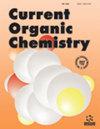Synthesis of Novel Propynyl Monoterpene Analogues and their Conjugates with β-DGlucopyranosides
IF 2.1
3区 化学
Q3 CHEMISTRY, ORGANIC
引用次数: 0
Abstract
: Camphor and carvone exhibit a broad spectrum of biological activity, which determines the prospect of their use as a platform for functionalization to obtain the analogues as potential drugs. The functionalization of camphor and carvone often involves changes to the skeleton of the molecules or their fragmentation. Therefore, in modern medicinal chemistry, research aimed at the development of effective approaches to the synthesis of semi-synthetic derivatives of camphor and carvone with preservation of the native framework, demonstrating high biological activity, is in demand. The present work is aimed at the synthesis of new propynyl analogues of camphor and carvone, as well as their conjugates with mono- and disaccharides via Cu-catalyzed cycloaddition of acetylenes and azides (CuAAC). Alkylation of camphor and carvone with propargyl bromide in the presence of the base KN(SiMe3)2–Et3B in 1,2-dimethoxyethane (DME) at room temperature provides the target products with yields of 69% and 47%, respectively. Glycosyl azides were obtained by the reaction of peracetylated sugars with trimethylsilyl azide in the presence of SnCl4.The synthesis of 1,2,3-triazolyl glycoconjugates of camphor and carvone with mono- and disaccharides was carried out through Cu(I)-catalyzed 1,3-dipolar cycloaddition of azides to acetylenes (CuAAC) in the presence of Cu and CuSO4·5H2O. The structures of the synthesized compounds were determined by NMR. The new propynyl-substituted camphor and carvone, as well as their 1,2,3-triazolylglycoconjugates, can be used as promising building blocks for medicine chemistry.新型丙炔基单萜烯类似物及其与 β-DGlucopyranosides 的共轭物的合成
:樟脑和香芹酮具有广泛的生物活性,这决定了它们有望被用作功能化平台,以获得类似物作为潜在药物。樟脑和香芹酮的功能化通常涉及改变分子的骨架或使其破碎。因此,在现代药物化学中,需要开发有效的方法来合成樟脑和香芹酮的半合成衍生物,同时保留其原生骨架,并显示出较高的生物活性。本研究旨在通过铜催化的乙炔和叠氮化物环加成(CuAAC)合成樟脑和香芹酮的新丙炔基类似物及其与单糖和二糖的共轭物。室温下,在 1,2 二甲基甲氧基乙烷(DME)中,在碱 KN(SiMe3)2-Et3B 的存在下,樟脑和香芹酮与溴化丙炔发生烷基化反应,生成的目标产物的产率分别为 69% 和 47%。在 Cu 和 CuSO4-5H2O 的存在下,通过 Cu(I)-catalyzed 1,3-dipolar cycloaddition of azides to acetylenes (CuAAC),合成了樟脑和香芹酮与单糖和二糖的 1,2,3-三唑基糖共轭物。通过核磁共振确定了合成化合物的结构。新的丙炔基取代的樟脑和香芹酮以及它们的 1,2,3-三唑基甘氨酰共轭物可作为药物化学的有前途的构建基块。
本文章由计算机程序翻译,如有差异,请以英文原文为准。
求助全文
约1分钟内获得全文
求助全文
来源期刊

Current Organic Chemistry
化学-有机化学
CiteScore
3.70
自引率
7.70%
发文量
76
审稿时长
1 months
期刊介绍:
Current Organic Chemistry aims to provide in-depth/mini reviews on the current progress in various fields related to organic chemistry including bioorganic chemistry, organo-metallic chemistry, asymmetric synthesis, heterocyclic chemistry, natural product chemistry, catalytic and green chemistry, suitable aspects of medicinal chemistry and polymer chemistry, as well as analytical methods in organic chemistry. The frontier reviews provide the current state of knowledge in these fields and are written by chosen experts who are internationally known for their eminent research contributions. The Journal also accepts high quality research papers focusing on hot topics, highlights and letters besides thematic issues in these fields. Current Organic Chemistry should prove to be of great interest to organic chemists in academia and industry, who wish to keep abreast with recent developments in key fields of organic chemistry.
 求助内容:
求助内容: 应助结果提醒方式:
应助结果提醒方式:


